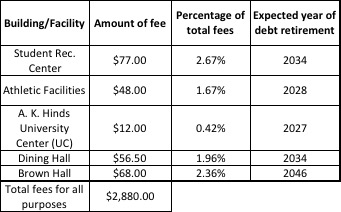
Brown Cafeteria will be fully constructed by the time students come back in the Fall, but students will be contributing to its debts for almost 30 years to come. Photo by Yustin Riopko
In-state full-time WCU students will be paying $4,865.50 for tuition and required fees next semester, and their out-of-state counterparts will be paying more than twice that amount. Those prices don’t include other program and major fees or optional charges like food and residence.
The bottom line is – college is expensive!
So when students are paying so much for their education, it’s reasonable that they wonder where their money is going. Of course we know of things like faculty and staff salaries, buildings, electricity, and the like, but there are programs and facilities that most students probably don’t know they’re directly funding. The Western Carolina Journalist has done a little bit of research to uncover some things you didn’t know you were paying for.
After the waivable $1,270 health insurance fee, the largest required fee is the Athletic Fee. According to Athletic Director Randy Eaton, this $378.00-per-student fee accounts for about 54 percent of the athletic department’s budget.
Eaton explained that the budget is broken up into three categories: scholarships, personnel benefits, and operating costs. Scholarships make up 30.5 percent of the budget; personnel benefits make up 45 percent; and operating costs make up 24.5 percent. Danny Ranz wrote an article for WCJ outlining specifics for the athletic department’s projects and priorities for the future. One of those plans is a new indoor practice facility for the football team.
Head football coach Mark Speir believes a new place to practice would seriously improve efficiency for Catamount football.
“We have 105 players so practicing with everyone can be tight,” said Spier. “This facility would give us two fields so the offense and defense can both practice instead of waiting for the others to be done.”
One of the next biggest fees is the $272 Education and Technology Fee, which according to the official WCU Tuition and Fees website “provide[s] for specialized instructional supplies and services and for scientific and information technology equipment not provided by State funds.”
WCU Provost and Vice Chancellor for Academic Affairs Dr. Alison Morrison-Shetlar was unable to provide any information on specific programs supported by the education side of the Ed. and Tech. Fee at this busy time of the year, but WCU Chief Information Officer Craig Fowler provided a general list of services supported by the technology side of it.
Some of the things on Fowler’s list were software costs, student membership licenses (myWCU, Blackboard, Office 365, etc.), and Technology Commons services, such as computer repair and equipment checkout.

The Dining Hall is one of the facilities whose debt we are still paying fees to retire. Photo by Yustin Riopko.
 One of the things we all know we’re paying for are buildings, but did you know that some of your Tuition and Fees is being used to pay off costs for existing facilities? Above is a condensed list of fees aimed specifically to alleviate indebtedness for things on campus that we already have and use. Director of budgets Greg Hodges provided the year of debt retirement for each facility.
One of the things we all know we’re paying for are buildings, but did you know that some of your Tuition and Fees is being used to pay off costs for existing facilities? Above is a condensed list of fees aimed specifically to alleviate indebtedness for things on campus that we already have and use. Director of budgets Greg Hodges provided the year of debt retirement for each facility.
You can see a full list of the required undergraduate fees, which include the Education and Technology, Health Service, Student Activity, and other fees, on the official WCU Tuition and Fees website.
Another one of those fees is the Sustainability fee, which according to the WCU website, “funds environmental initiatives and student learning opportunities.”
This $5 fee goes to the budget of the Sustainable Environment Initiative Committee, a group of faculty and students who make decisions regarding sustainable projects on campus. SEI’s projects include the Electron Garden on the Green, a solar-powered hammock lounge at the front of campus, and the Dirtmaker, an interactive art piece along the WCU hiking trail system that replenishes minerals in the forest soil. SEI’s other environmentally thoughtful endeavors are detailed more thoroughly in this article by Rachel Plouse.
Some students are happy with the projects allowed by the Sustainability Fee. Other students who aren’t fully behind the initiatives still find the cost acceptable.
Graduating senior Grant McKinstrie said, “They’re cool things to have, and they’re cool projects, so I don’t want to say it was useless to do them. They add something to our campus for people to go and use. I didn’t know I’ve been paying a $5.00 fee for sustainability, and I was initially surprised to find that out, but compared to the $12.00 I just spent on dinner, it’s not a big deal.”
There are a lot of required fees and student-funded programs and facilities at Western, and this is only the tip of the iceberg. Stay tuned with the WCJ for more information on things you didn’t know you were paying for.
For now, you can continue to explore how the university spends money with other WCJ stories.



